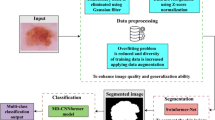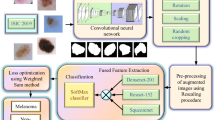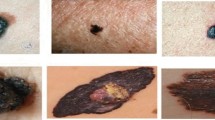Abstract
Skin cancer is one of the world’s most hazardous diseases, and identification of skin cancer is more challenging. Recently Deep learning algorithms have evolved to produce outstanding outcomes in a wide range of clinical practices. But classifying different classes of skin cancer is complex due to the fine-grained variability of skin lesion regions. Based on this insight, the current work considers an early and accurate multi-class skin cancer classification issue by introducing a novel deep learning model. As typical deep learning models have fewer receptive fields, they are unable to gather global context information from wider regions, making it difficult to identify diseased areas. Furthermore, in previous studies, the segmented skin lesion region caused higher noise and worse classification accuracy. To overcome the existing problem, a novel Multi-class Dilated D-Net (MD2N) framework is introduced to segment and classify multiple classes of skin cancer screening. The encoder phase of the proposed MD2N reduces feature information losses by adopting a downsampling ratio while also distinguishing small skin lesion patches. Dilated manifold Parallel convolution effectively expands the network’s receptive field and eliminates the “grid issue” that plagues ordinary dilated convolution. As a result, the model can get more rich feature information of skin lesions areas of dissimilar sizes. Further, the proposed deep learning model initiates the system to accurately segment and classify lesion regions from the input skin image obtained from International Skin Imaging Collaboration.







Similar content being viewed by others
References
Abd ElGhany S, Ibraheem MR, Alruwaili M, Elmogy M (2021) Diagnosis of various skin Cancer lesions based on fine-tuned ResNet50 deep network. Cmc-Computers Materials & Continua 68(1):117–135. https://doi.org/10.32604/cmc.2021.016102
Adla D, Reddy G, Nayak P, Karuna G (2021) Deep learning-based computer aided diagnosis model for skin cancer detection and classification. Distrib Parallel Databases 1-20. 40:717–736. https://doi.org/10.1007/s10619-021-07360-z
Ain QU, Al-Sahaf H, Xue B, Zhang M (2020) Generating knowledge-guided discriminative features using genetic programming for melanoma detection. IEEE Trans Emerg Top Comput Intell 5(4):554–569. https://doi.org/10.1109/TETCI.2020.2983426
Al-Masni MA, Kim DH, Kim TS (2020) Multiple skin lesions diagnostics via integrated deep convolutional networks for segmentation and classification. Comput Meth Prog Bio 190:105351. https://doi.org/10.1016/j.cmpb.2020.105351
Anjum MA, Amin J, Sharif M, Khan HU, Malik MSA, Kadry S (2020) Deep semantic segmentation and multi-class skin lesion classification based on a convolutional neural network. IEEE Access 8:129668–129678. https://doi.org/10.1109/ACCESS.2020.3009276
Arora G, Dubey AK, Jaffery ZA, Rocha A (2020) Bag of feature and support vector machine-based early diagnosis of skin cancer. Neural Comput Appl 1-8. https://doi.org/10.1007/s00521-020-05212-y
Chaturvedi SS, Tembhurne JV, Diwan T (2020) A multi-class skin Cancer classification using deep convolutional neural networks. Multimed Tools Appl 79(39):28477–28498. https://doi.org/10.1007/s11042-020-09388-2
Demir A, Yilmaz F, Kose O (2019) October. Early detection of skin cancer using deep learning architectures: resnet-101 and inception-v3. In 2019 medical technologies congress (TIPTEKNO) IEEE 1-4. https://doi.org/10.1109/TIPTEKNO47231.2019.8972045.
Dorj UO, Lee KK, Choi JY, Lee M (2018) The skin cancer classification using a deep convolutional neural network. Multimed Tools Appl 77(8):9909–9924. https://doi.org/10.1007/s11042-018-5714-1
Gaikwad PS, Shete AS, Patil MH, Rane AS (2021) Skin Cancer detection using image processing. Int J Adv Sci Res Eng Trends 6(1). https://doi.org/10.51319/2456-0774.2021.0015
Hekler A, Utikal JS, Enk AH, Hauschild A, Weichenthal M, Maron RC, Berking C, Haferkamp S, Klode J, Schadendorf D, Schilling B, Holland-Letz T, Izar B, von Kalle C, Fröhling S, Brinker TJ, Schmitt L, Peitsch WK, Hoffmann F, Thiem A (2019) Superior skin cancer classification by the combination of human and artificial intelligence. Eur J Cancer 120:114–121. https://doi.org/10.1016/j.ejca.2019.07.019
Hosny KM, Kassem MA, Foaud MM (2019) Classification of skin lesions using transfer learning and augmentation with Alex-net. PLoS One 14(5):e0217293. https://doi.org/10.1371/journal.pone.0217293
Huang HW, Hsu BWY, Lee CH, Tseng VS (2021) Development of a light-weight deep learning model for cloud applications and remote diagnosis of skin cancers. J Dermatol 48(3):310–316. https://doi.org/10.1111/1346-8138.15683
Jiang S, Li H, Jin Z (2021) A visually interpretable deep learning framework for histopathological image-based skin cancer diagnosis. IEEE J Biomed Health Inform 25(5):1483–1494. https://doi.org/10.1109/jbhi.2021.3052044
Jinnai S, Yamazaki N, Hirano Y, Sugawara Y, Ohe Y, Hamamoto R (2020) The development of a skin cancer classification system for pigmented skin lesions using deep learning. Biomolecules 10(8):1123. https://doi.org/10.3390/biom10081123
Kadampur MA, Al Riyaee S (2020) Skin cancer detection: applying a deep learning based model driven updates architecture in the cloud for classifying dermal cell images. Inform Med Unlocked 18:100282. https://doi.org/10.1016/j.imu.2019.100282
Khamparia A, Singh PK, Rani P, Samanta D, Khanna A, Bhushan B (2021) An internet of health things-driven deep learning framework for detection and classification of skin cancer using transfer learning. Trans Emerg Telecommun. Technol 32(7):e3963. https://doi.org/10.1002/ett.3963
Khan MA, Muhammad K, Sharif M, Akram T, de Albuquerque VHC (2021) Multi-class skin lesion detection and classification via Teledermatology. IEEE J Biomed Health Inform 25(12):4267–4275. https://doi.org/10.1109/jbhi.2021.3067789
López-Leyva JA, Guerra-Rosas E, Álvarez-Borrego J (2021) Multi-class diagnosis of skin lesions using the Fourier spectral information of images on additive color model by artificial neural network. IEEE Access 9:35207–35216. https://doi.org/10.1109/access.2021.3061873
Majji R, Om Prakash PG, Cristin R, Parthasarathy G (2020) Social bat optimisation dependent deep stacked auto-encoder for skin cancer detection. IET Image Process 14(16):4122–4131. https://doi.org/10.1049/iet-ipr.2020.0318
Murugan A, Nair SAH, Kumar KS (2019) Detection of skin cancer using SVM, random forest, and kNN classifiers. J Med Syst 43(8)L:1-9. https://doi.org/10.1007/s10916-019-1400-8.
Murugan A, Nair SAH, Preethi AAP, Kumar KS (2021) Diagnosis of skin cancer using machine learning techniques. Microprocess Microsyst 81:103727. https://doi.org/10.1016/j.micpro.2020.103727
Pham TC, Doucet A, Luong CM, Tran CT, Hoang VD (2020) Improving skin-disease classification based on customized loss function combined with balanced mini-batch logic and real-time image augmentation. IEEE Access 8:150725–150737. https://doi.org/10.1109/ACCESS.2020.3016653
Privalle A, Havighurst T, Kim K, Bennett DD, Xu YG (2020) Number of skin biopsies needed per malignancy: comparing the use of skin biopsies among dermatologists and non dermatologist clinicians. J Am Acad Dermatol 82(1):110–116. https://doi.org/10.1016/j.jaad.2019.08.012
Rajput G, Agrawal S, Raut G, Vishvakarma SK (2022) An accurate and noninvasive skin cancer screening based on imaging technique. Int J Imaging Syst Technol 1-15. https://doi.org/10.1002/ima.22616.
Rezvantalab A, Safigholi H, Karimijeshni S (2018) Dermatologist level dermoscopy skin cancer classification using different deep learning convolutional neural network algorithms. arXiv preprint arXiv:1810.10348
Song L, Lin J, Wang ZJ, Wang H (2020) An end-to-end multi-task deep learning framework for skin lesion analysis. IEEE J Biomed Health Inform 24(10):2912–2921. https://doi.org/10.1109/jbhi.2020.2973614
Tan TY, Zhang L, Lim CP (2019) Intelligent skin cancer diagnosis using improved particle swarm optimization and deep learning models. Appl Soft Comput 84:105725. https://doi.org/10.1016/j.asoc.2019.105725
Thanh DN, Prasath VB, Hieu LM, Hien NN (2020) Melanoma skin cancer detection method is based on adaptive principal curvature, color italicization, and feature extraction with the ABCD rule. J Digit Imaging 33(3):574–585. https://doi.org/10.1007/s10278-019-00316-x
Thurnhofer-Hemsi K, Dominguez E (2021) A convolutional neural network framework for accurate skin cancer detection. Neural process. Lett 53(5):3073–3093. https://doi.org/10.1007/s11063-020-10364-y
Toğaçar M, Cömert Z, Ergen B (2021) Intelligent skin cancer detection applying autoencoder, MobileNetV2 and spiking neural networks. Chaos, Solitons Fractals 144:110714. https://doi.org/10.1016/j.chaos.2021.110714
Yap J, Yolland W, Tschandl P (2018) Multimodal skin lesion classification using deep learning. Exp Dermatol 27(11):1261–1267. https://doi.org/10.1111/exd.13777
Author information
Authors and Affiliations
Corresponding author
Ethics declarations
Conflict of interest
The authors declare that we have no conflict of interest.
Additional information
Publisher’s note
Springer Nature remains neutral with regard to jurisdictional claims in published maps and institutional affiliations.
Rights and permissions
Springer Nature or its licensor (e.g. a society or other partner) holds exclusive rights to this article under a publishing agreement with the author(s) or other rightsholder(s); author self-archiving of the accepted manuscript version of this article is solely governed by the terms of such publishing agreement and applicable law.
About this article
Cite this article
Kumar, M.D., Sivanarayana, G.V., Indira, D. et al. Skin cancer segmentation with the aid of multi-class dilated D-net (MD2N) framework. Multimed Tools Appl 82, 35995–36018 (2023). https://doi.org/10.1007/s11042-023-14605-9
Received:
Revised:
Accepted:
Published:
Issue Date:
DOI: https://doi.org/10.1007/s11042-023-14605-9




